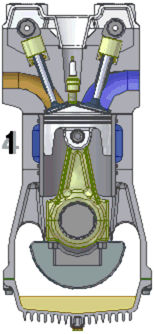What is exactly DTS-i ,DTS-Si and DTS-Fi? Is it a real technological break through or just some techno-jargon used for marketing?
Lets first take a look at how a 4 stroke engine works.
Conventional 4 stroke Engine-
The cycle begins when the piston is furthest away from the crankshaft. On the first stroke (intake/induction) of the piston, as the piston descends it reduces the pressure in the cylinder, a mixture of fuel and air is forced, by at least atmospheric pressure, into the cylinder through the intake port. The intake valve then closes and the following stroke (compression) compresses the fuel-air mixture. The air-fuel mixture is then ignited, by a spark plug, at approximately the top of the compression stroke. The resulting expansion of burning gases pushes the piston downward for the third stroke (power) and in the fourth stroke (exhaust) the piston pushes the products of combustion from the cylinder through an exhaust valve or valves. DTS-i Engine can be further tuned to deliver exhilarating performance as in DTS-FI or exceptional mileage like in DTS-SI as claimed by Bajaj. The use of twin spark plugs has been around for decades mostly in the engine of Alfa Romeo, Honda and on large capacity Ducati engine etc. Bajaj however have patented the technology for small capacity engines. DTS-Si Engine - Like DTS-i the engine has 2 spark plugs, but, instead of conventionally positioned straight ports, the offset positioning of the ports generate high swirl and turbulence of the air fuel mixture in the combustion chamber. This results in highly efficient combustion that further results in exceptional mileage. Like the mother DTS-i technology, the DTS-Si technology is a patented technology developed by Bajaj Auto R&D. This technology is used by Bajaj in its recently launched 125 cc Bajaj XCD. Recently, Bajaj Auto was in the news for accusing TVS Motors, long-standing rivals of patent infringement on the DTSi technology. TVS countered by threatening to sue Bajaj Auto for libel. DTS-Fi- DTS-Fi stands for "Digital Twin Spark Fuel Injection", a ‘Bajaj Patented Technology’. In fuel injection the conventional carburettor has been replaced by injector which injects fuel in to the engine in a spray form based on the instructions of the Engine Control Unit (ECU) which is a part of the Engine Management System EMS. The Electronic Control Unit (ECU) is microprocessor based and is the brain of the fuel injection system. It processes information sent by various sensors and instantly determines optimum fueling and spark timing for various engine operating conditions. The ECU contains detailed information of the engine's characteristics from which it picks the necessary data for commanding both fueling & spark timing. The main advantages of Fuel Injection are: a. Increased power output for same cc. b. Better low end torque. c. Lower fuel delivery & optimisation of spark timing. d. Improved cold start, quick warm-up and excellent response to sudden acceleration. e. Lower emission levels. f. Self detection and communication of fuel system malfunctioning if any. ExhausTECExhausTEC stands for Exhaust Torque Expansion Chamber, a Bajaj Auto trademark. The technology involves use of a small chamber connected to the exhaust pipe of the engine to modify the back-pressure and the swirl characteristics, with an aim to improve the low-end performance of the bikes. This was attempted in response to the issue of a reported lack of low-end response in Bajaj's single-cylinder four-stroke engines. The ExhausTEC technology is claimed to be highly effective in improving the overall engine response, especially the low-end torque characteristics. This enhanced performance is claimed to come at no loss of top-end performance or engine smoothness. |
Motorcycle engine wikipedia






.jpg)
5 comments:
Bravo Kedar..!!
gud info kedar...that was a concise yet precise briefing of engine technology.
it mean 100cc and 125cc engine is physically same size ?
it means 100cc engine and 125cc engine is physically same size?
hi kedar, this is gopal from Hyderabad. I'm working for a student magazine in Hyderabad. Recently i have read your article on DTSi, 4stroke engine and DTS-SI... I want to give life for this article by publishing this article.... plz reach me at :: igopal4u@gmail.com
Post a Comment